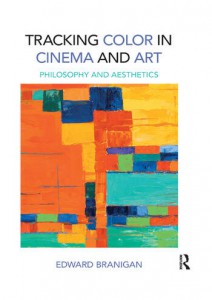On a related topic:
Color in Motion (2024)
Chromatic Explorations of Cinema
by Alexandra James Salichs, Kirsten Moana Thompson, Barbara Flueckiger and Joshua Yumibe
Subject: Technique > Aesthetics
Cinéma et couleur (2009)
Film and Colour
by Raphaëlle Costa de Beauregard
(in English and French)
Subject: Technique > Aesthetics
Cinema by Design (2017)
Art Nouveau, Modernism, and Film History
by Lucy Fischer
Subject: Technique > Aesthetics
Theorizing Film Through Contemporary Art (2020)
Expanding Cinema
Dir. Jill Murphy and Laura Rascaroli
Subject: Theory
Tracking Color in Cinema and Art
Philosophy and Aesthetics


Average rating: ![]()
| 0 | rating | |
| 0 | rating | |
| 0 | rating | |
| 0 | rating |
Your rating: -
Book Presentation:
Color is one of cinema’s most alluring formal systems, building on a range of artistic traditions that orchestrate visual cues to tell stories, stage ideas, and elicit feelings. But what if color is not—or not only—a formal system, but instead a linguistic effect, emerging from the slipstream of our talk and embodiment in a world? This book develops a compelling framework from which to understand the mobility of color in art and mind, where color impressions are seen through, and even governed by, patterns of ordinary language use, schemata, memories, and narrative.
Edward Branigan draws on the work of Ludwig Wittgenstein and other philosophers who struggle valiantly with problems of color aesthetics, contemporary theories of film and narrative, and art-historical models of analysis. Examples of a variety of media, from American pop art to contemporary European cinema, illustrate a theory based on a spectator’s present-time tracking of temporal patterns that are firmly entwined with language use and social intelligence.
About the Author:
Edward Branigan is Professor Emeritus in the Department of Film and Media Studies at the University of California, Santa Barbara. He is the author of Projecting a Camera: Language-Games in Film Theory; Narrative Comprehension and Film; and Point of View in the Cinema: A Theory of Narration and Subjectivity in Classical Film. With Warren Buckland, he is the editor of The Routledge Encyclopedia of Film Theory. With Charles Wolfe, he is the general editor of the American Film Institute Film Readers series.
Press Reviews:
'This is an extraordinary achievement -- a major work (perhaps Branigan's most impressive yet) by one of our most important film theorists and philosophers. While color studies in film have exploded over the last fifteen years, most of the work has moved very cautiously and largely in a historicist fashion, one that privileges accounts of emerging technological innovations and to a lesser extent style at the expense of the fascinating perceptual questions color and color filmmaking raises. Branigan takes these questions head on and the results are positively stunning. It is the first book -- in film studies, at least -- to deal at great length and specificity with the question of color perception and color style. As I mentioned, most books shy away from stylistic analysis and the rich philosophical questions that color poses about perception and, as Branigan indicates very daringly, about how real the real world is.' -- Brian Price, University of Toronto
'Branigan takes a Wittgensteinian approach to color that "focuses not on what color is, but on how it functions, what it does for us, what we make of it." For our delectation, he offers us an extraordinarily rich and provocative feast that takes us beyond cinema to the uses and meanings of color in painting, philosophy and literature.' -- C.L. Hardin, Professor of Philosophy, Emeritus, Syracuse University. Author of Color for Philosophers: Unweaving the Rainbow (1993).
See the publisher website: Routledge